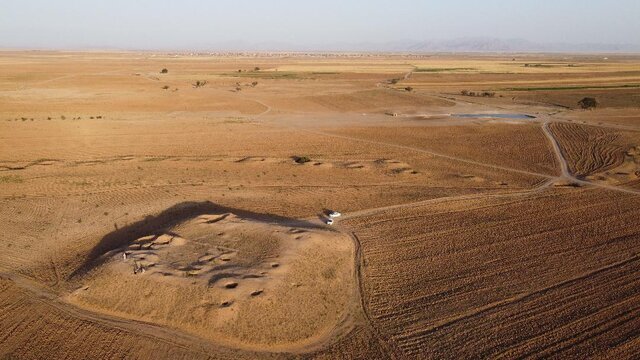Sassanid ruins unearthed in central Iran

TEHRAN–A team of Iranian archaeologists has unearthed portions of an ancient Sassanid structure during its excavations in the Davudabad region of Markazi province.
“We have found the entrance and walls of a Sasanian building following one month of excavation,” ISNA quoted archaeologist Mohammedreza Nemati as saying on Monday.
The surrounding fortifications comprise two parallel thick walls with a width of 125 cm and a corridor embedded between these two walls, Namati, who leads the survey, stated.
“The walls are made of bricks measuring 12x40x40 cm and 12x54x54 cm with white-colored mud mortar. The clays used in the walls are also prepared from local soil and are often of low quality and are whitish and bright red with a large amount of coarse sand and pebbles,” the archaeologist explained.
Moreover, the archaeologist says the corridor leads to an oval-shaped tower. “The entire surface of the walls as well as the corridor’s floor are plastered. And, in the eastern part of the trench, there is a corridor that leads to an oval-shaped tower, parts of its cradled roof with a curved arch have remained intact.”
Elsewhere in his remarks, the archaeologist said: “The bricks used in the tower are 12 x 34 x 34 cm and smaller than the bricks of the walls, and to strengthen the wall of the tower, its outer part is filled with a whitish layer.”
“We believe that the western part of the structure is unearthed according to the aerial and topographical images… and probably the eastern part is also the same.”
Due to the deliberate abandonment of this building, no flawless object is found so far, and the most important find of this season is the remains of a clay jar, which has many carved decorations on its outer body surface. In addition, a number of ram's horns, bones related to boars, game spears, stone tools, and many pieces of pottery were found.

According to the architectural findings and the available evidence, this building was not residential, and it seems to be a building with a religious function.
In addition, the ruins are estimated to date from the Sassanid period. It was completely abandoned in the early Islamic era, the expert said.
The Sassanid era is of very high importance in the history of Iran. Under the Sassanids, Persian architecture and the arts experienced a general renaissance. Architecture often took grandiose proportions, such as palaces at Ctesiphon, Firuzabad, and Sarvestan, which are amongst the highlights of the ensemble.
Generally, a Sassanid archaeological landscape represents a highly efficient system of land use and strategic usage of natural topography in the creation of the earliest cultural centers of the Sassanid civilization.
In 2018, an ensemble of Sassanian historical cities in southern Iran, titled “Sassanid Archaeological Landscape of Fars Region,” was named a UNESCO site. The ensemble comprises eight archaeological sites situated in three geographical parts of Firuzabad, Bishapur, and Sarvestan.
The World Heritage reflects the optimized usage of natural topography and bears witness to the influence of Achaemenid and Parthian cultural traditions and of Roman art, which later had a significant impact on the architecture and artistic styles of the Islamic era.
Apart from architecture, crafts such as metalwork and gem-engraving grew highly sophisticated, yet scholarship was encouraged by the state. In those years, works from both the East and West were translated into Pahlavi, the language of the Sassanians.
AM

Leave a Comment